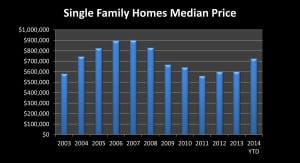How do appraisals work? This is a relatively common question in the real estate profession and one that often stems from confusion in the general public and even among professional’s in real estate of the industry. In this post I hope to give a very general overview of how an appraiser determines value and with any luck answer some questions that may be out there.

In any given appraisal, one of the first steps is to determine the problem and the purpose of the appraisal. Appraisals are not standard and are not used strictly to determined fair market value as of a current date. Appraisals are needed for a variety of reasons including:
- Market Valuations for Banks Lending Money
- Tax Appeals
- Market Valuations for Divorce purposes
- Retrospective Valuations; determining value of a property as of a past date
- Valuation “subject to” something specific taking place, such as a home being completed in a certain manner
- Valuation based on a hypothetical conditions/situation; For example, what if the zoning were different?
After determining the purpose of the appraisal it is key to determine the “Highest and Best Use” of the property. To arrive at the Highest and Best Use the use the property must pass all of these quick tests including:
- The use must be legally permissible?
- The use must be physically possible?
- The use must be maximally productive?
- The use must result in the highest value?

A use that passes all of these tests is the highest and best use. This use may not be the actual use of the property as of the date of the appraisal. For example, a single family home located on a commercially zoned property may have a higher and better use as a shopping center, or other commercial use. In this case, the property may be appraised as a commercial property vs. its current use as a home. A client requesting an appraisal may still want the property appraised under a specific use, but the highest and best use should still be determined.
Approaches to Value
There are three approaches considered when determining value in real estate. There approaches are the Sales Comparison Approach (Market Approach), the Cost Approach, and the Income Approach. Each approach can be beneficial in different types of appraisal situations and often an approach may not apply to a given property type.
The Sales Comparison Approach: This approach to value is used frequently in a variety of appraisals as it compares similar property types to a subject property (property being appraised), offering adjustments in value for variances in property characteristics. This approach is helpful because recent sales, or other listing types, offer insight to Buyer and Seller behavior. In other words, a recent sale demonstrates a seller’s willingness to sell and a buyer’s willingness to buy property at a given price. This approach is most valuable when the data being considered is recent and possesses similar property characteristics. The Sales Comparison Approach to value is often the primary approach to most single family home appraisals.
The Cost Approach to Value: The Cost Approach is a helpful technique, particularly with properties that are new or very unique. A church may be a good candidate whereby the cost approach is the primary approach to value. This is because there are generally few recent church sales in a given market, therefore making the sales comparison approach weak or not applicable. The Income Approach may not apply either as churches are not typically income generating. The cost approach is most helpful when a property is new because it has experienced little depreciation and therefore would require little consideration for depreciation attributed to time. Because depreciation is somewhat of a subjective calculation, greater levels of adjustment for depreciation result in greater potential for inaccuracy.
The Income Approach to Value: The Income Approach to value is particularly useful when appraising income producing properties. Generally speaking investors and appraisers look at a property’s income stream and make comparisons to anticipated rates of return in order to determine a fair market value. Appraisers may look at the sale of similar type income properties in order to find market rates of return. This approach to value is particularly useful when the property has a reliable income stream and desired rates of return are obvious.
The appraisal practice is complex and often requires a great deal professional education and experience in order to gain a comfortable understanding of its processes.
This article was written by Matthew Lehman, an SRA designated appraiser with the Appraisal Institute, and a Certified General Appraiser through the Bureau of Real Estate in California (BRE). Matthew has been appraising real estate in Mammoth Lakes, Mono County and San Diego for more than 23 years.
For information on home valuations in Mammoth Lakes, please visit Appraiser in Mammoth Lakes.




